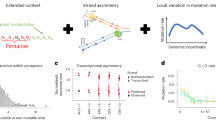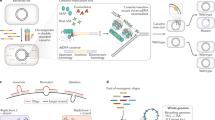Abstract
To identify transcribed sequences rapidly and efficiently, we have developed a recombination–based assay to screen bacteriophage λ libraries for sequences that share homology with a given probe. This strategy determines analytically whether a given probe is transcribed in a given tissue at a given time of development, and may also be used to isolate preparatively the transcribed sequence free of the screening probe. We illustrate this technology for the fragile X sequence, demonstrating that it is transcribed ubiquitously in an 11 week fetus, in a variety of 20 week human fetal tissues, including brain, spinal cord, eye, liver, kidney and skeletal muscle, and in adult jejunum
This is a preview of subscription content, access via your institution
Access options
Subscribe to this journal
Receive 12 print issues and online access
$209.00 per year
only $17.42 per issue
Buy this article
- Purchase on Springer Link
- Instant access to full article PDF
Prices may be subject to local taxes which are calculated during checkout
Similar content being viewed by others
References
Watt, V.M., Ingles, C.J., Urdea, M.S. & Rutter, W.J. Homology requirements for recombination in Escherichia coli. Proc. natn. Acad. Sci. U.S.A. 82, 4768–4772 (1985).
Shen, P. & Huang, H.V. Homologous recombination in Escherichia coli: dependence on substrate length and homology. Genetics 112, 441–457 (1986).
King, S.R. & Richardson, J.P. Role of homology and pathway specificity for recombination between plasmids and bacteriophage λ. Molec. gen. Genet. 204, 141–147, (1986).
Shen, P. & Huang, H.V. Effect of base pair mismatches on recombination via the RecBCD pathway. Molec. gen. Genet. 218, 358–360 (1989).
Verkerk, A.J. et al. Identification of a gene (FMR-1) containing a CGG repeat coincident with a breakpoint cluster region exhibiting length variation in fragile X syndrome. Cell 65, 905–914 (1991).
Pieretti, M. et al. Absence of expression of the FMR-1 gene in fragile X syndrome. Cell 66, 817–822 (1991).
Stewart, G.D. et al. Plasmids for recombination-based screening. Gene 106, 97–101 (1991).
Hanzlik, A.J., Osemlak, M.M. & Kurnit, D.M. A small plasmid for recombination-based screening. Gene (in the press).
Nisson, P.E., Rashtchian, A. & Watkins, P.C. Rapid and efficient cloning of Alu-PCR products using uracil DNA glycosylase. PCR Meth. Applic. 1, 120–123 (1991).
Seed, B. Purification of genomic sequences from bacteriophage libraries by recombination and selection in vivo. Nucl. Acids Res. 11, 2427–2445 (1983).
Kurnit, D.M. & Seed, B. Improved genetic selection for screening bacteriophage libraries by homologous recombination in vivo. Proc. natn. Acad. Sci. U.S.A. 87, 3166–3169 (1990).
Georgopoulos, C. & Herskowitz, I. in The Bacteriophage Lambda, (ed. Hershey, A.D.) 553–563 (Cold Spring Harbor, New York, 1971).
Saiki, R.K. et al. Enzymatic amplification of β-globin genomic sequences and restriction site analysis for diagnosis of sickle cell anemia. Science 230, 1350–1354 (1985).
Fu, Y.H. et al. Variation of the CGG repeat at the fragile X site results in genetic instability: resolution of the Sherman paradox. Cell 67, 1047–1058 (1991).
Neve, R.L. et al. Human chromosome 21 -encoded cDNA clones. Gene 49, 361–369 (1986).
Short, J.M., Fernandez, J.M., Sorge, J.A. & Huse, W.D. λZAP: a bacteriophage λ expression vector with in vivo excision properties. Nucl. Acids Res. 16, 7583–7600 (1985).
Uberbacher, E.G. & Mural, R.J. Locating protein-coding regions in human DNA sequences by a multiple sensor-neural network approach. Proc. natn. Acad. Sci. U.S.A. 88, 11261–11265 (1991).
Liu, P., Legerski, R. & Siciliano, M.J. Isolation of human transcribed sequences from human-rodent somatic cell hybrids. Science 246, 813–815 (1989).
Duyk, G.M., Kim, S., Myers, R.M. & Cox, D.R. Exon trapping: a genetic screen to identify candidate transcribed sequences in cloned mammalian genomic DNA. Proc. natn. Acad. Sci. U.S.A. 87, 8995–8999 (1990).
Buckler, A.J. et al. Exon amplificaton: a strategy to isolate mammalian genes based on RNA splicing. Proc. natn. Acad. Sci. U.S.A. 88, 4005–4009 (1991).
Lovett, M., Kere, J. & Hinton, L.M. Direct selection: a method for the isolation of cDNAs encoded by large genomic regions. Proc. natn. Acad. Sci. U.S.A. 88, 9628–9632 (1991).
Parimoo, S., Patanjali, S.R., Shukla, H., Chaplin, D.D. & Weissman, S.M. cDNA selection: efficient PCR approach for the selection of cDNAs encoded in large chromosomal DNA fragments. Proc. natn. Acad. Sci. U.S.A. 88, 9623–9627 (1991).
Adams, M.D. et al. Complementary DNA sequencing: expressed sequence tags and human genome project. Science 252, 1651–1656 (1991).
Guarente, L., Lauer, G., Roberts, T.M. & Ptashne, M. Improved methods for maximizing expression of a cloned gene: a bacterium that synthesizes rabbit β-globin. Cell 20, 543–553 (1980).
Casadaban, M.J. & Cohen, S.N. Analysis of gene control signals by DNA fusion and cloning in Escherichia coli. J. molec. Biol. 138, 179–207 (1980).
Author information
Authors and Affiliations
Rights and permissions
About this article
Cite this article
Hanzlik, A., Osemlak-Hanzlik, M., Hauser, M. et al. A recombination–based assay demonstrates that the fragile X sequence is transcribed widely during development. Nat Genet 3, 44–48 (1993). https://doi.org/10.1038/ng0193-44
Received:
Accepted:
Issue Date:
DOI: https://doi.org/10.1038/ng0193-44



